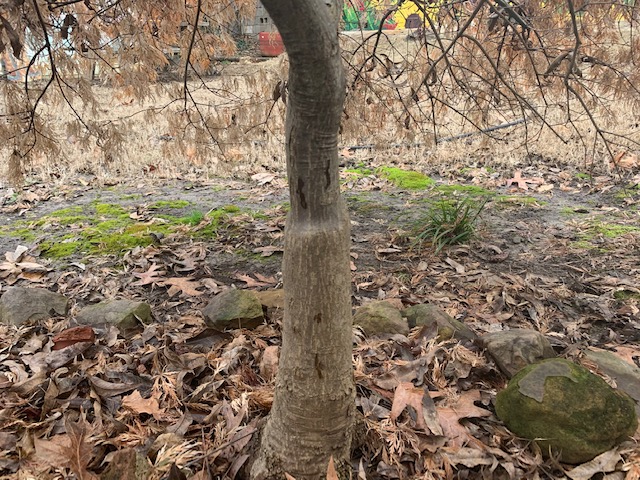Frost Advisory for Northern 1/3 of Arkansas
It is not often that we see this headline in May. The cooler than normal spring has thrown some curve balls at all gardeners across the State. Some of you have had hail, floods, wind gusts, tornado, and now a pending late frost.
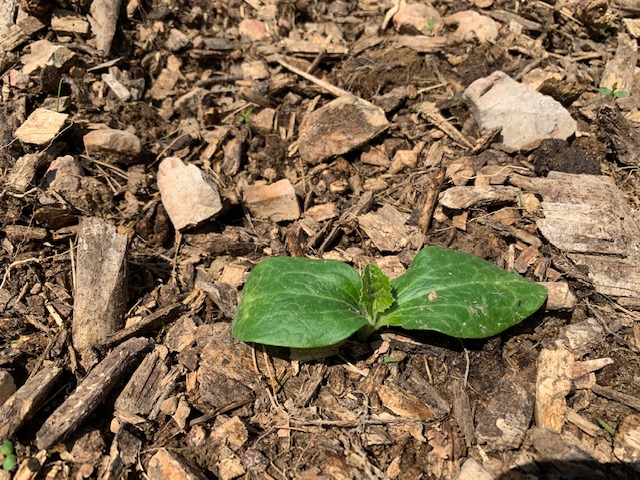

Potato Hilling
Potatoes are among the earliest vegetables planted in the garden. Planted early to mid-February through early March in southern Arkansas and early March to early April in northern Arkansas. You will need to mound soil up and around potatoes after they break the surface of the ground. Gradually build up a low ridge of loose soil by hoeing soil towards the plants from both sides. This ridge, may become 4 to 6 inches high and will reduce the number of sunburned (greened) tubers. Additionally, this cultivation will eliminate weeds and aerate the soil which aids in the development of normal shaped potatoes versus when the tubers develop in challenging hard, compacted soil.

This row of potatoes, in my vegetable garden in Fayetteville were planted the last week of March and have been hilled up twice to its current height.
Mulching is usually helpful in growing potatoes. This is the same row which was hilled earlier. The straw mulch helps to conserve moisture and keep weeds under control. Mulch will also keep the soil cooler which aids in maximum tuber production. Before placement of straw, I side dressed with a small amount of fertilize. I used blood meal, approximately 1 tablespoon scattered around each plant. Because I’m between Little Rock and Fayetteville, I plan on putting a drip system in and around these just in case we hit a dry spell. I’m set for a good harvest in June.
Ben Morrison Azalea
One of the first shrubs Marilyn and I planted when we moved to our present home in Fayetteville is this bi-color azalea known as Ben Morrison. This late blooming upright, semi-evergreen rounded shrub, will reach 6 feet tall and wide. In southern Arkansas this plant is evergreen but on the boundary line between zone 6 and 7 where I garden, it loses many of its larger leaves but retains its smaller late season leaves. Ben Morrison’s open airy growth habit fits in well near my front porch shade garden.

Should I Trim or Braid or Do Nothing?
No I’m not doing hair these days. These questions are often asked about this time of year as daffodils and other spring flowering bulbs finish blooming. The answer is quite simple but most often not adhered to. Allow bulb foliage to mature naturally without disturbance. The time required depends on the species. Tulip foliage dies five to six weeks after flowering. Daffodil foliage may persist for 10 to 12 weeks. If the foliage is removed early, the bulbs will be small next year, thus reducing the beauty of the display. Techniques such as braiding the foliage, squashing it or trimming back should not be used. It is acceptable to plant annual bedding plants between the clumps of dying foliage. Contact me, Berni Kurz through this page or at bkurz@uaex.edu if you have any questions.

Calling All Bradford Pears
Blooming Bradford pear trees are a sure sign of early spring in Arkansas. While the blooms are lovely, the trees do not weather well over time. Bradford pears are poorly formed trees with many limbs originating from a central location. This characteristic creates a weak spot in the tree that makes Bradford pears susceptible to storm damage and greatly reduces the potential life span of the trees.

These Bradford pears are on I 630 right of way in Little Rock. The city of Fayetteville is the only town in Arkansas which has put Bradford and other Callary Pears on their do not plant list. You ask why? Bradford pears were believed to be sterile upon their introduction to the United States in the mid 1960’s. What we now know is, while no two Bradford pears will reproduce among themselves, they do cross pollinate with other pear trees to create a wild type hybrid tree. The resulting trees create thorny thickets that have many negative impacts on our native tree populations and has a domino effect onto wildlife which depended on the native plants for survival.

This scene of pears coming up in the native landscape, can be found all across Arkansas and all other regions where Bradford Pears have been planted. Now is the time to flag these trees for removal. If you do lose a ‘Bradford’ in your landscape, don’t replace it with a new Bradford or any type of “improved” ornamental pear. The Bradford pear cultivar, other P. calleryana cultivars and P. betulifolia or Asian pear, can hybridize and produce fertile fruit, compounding the invasive problem.

There are better options for landscape trees that are longer living, more suitable for Arkansas, and support wildlife. This picture is of Serviceberry, Amelanchier arborea, which will be in bloom a little later than Bradford Pears. Serviceberry growing in full sun will produce a heavier bloom than shown in this picture. This tree will also bear edible fruit which requires no spraying and little to no pruning. Other good substitutes include: Flowering Dogwood (Cornus florida) and Fringe Tree (Chionanthus virginicus). For more information on invasive plant species, contact your local County Agents office or me Berni Kurz at bkurz@uaex.edu
Spring has Sprung in Southern Arkansas
We live in a small State, but we have a broad range of temperature from the northern Arkansas to the southern border. This is more apparent in the spring months when we as gardeners want to get a jump on the gardening season. The last average frost in Southeast Arkansas typically occurs on March 18 and in some northern tier counties the last frost is a month later, April 15. Gardeners in Southern Arkansas are busy planting spring gardens right now while Northern Arkansas gardeners are chomping at the bits.
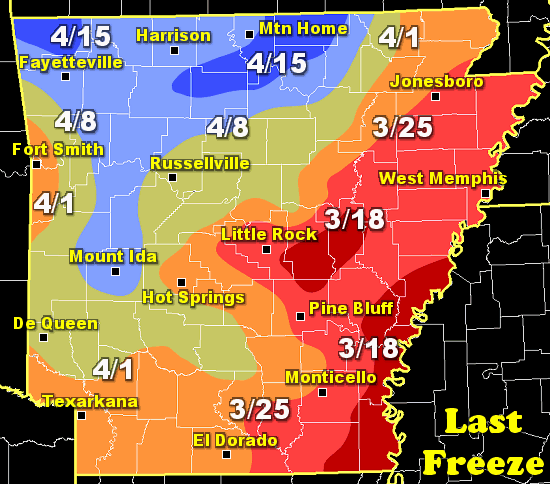
Keep in mind, when planting frost sensitive plants before the last frost, you will need to provide frost protection on those cold frosty nights. Also, plants like peppers, if planted now, and you are successful at protecting them from frost, they will be chilled and will be slow to recover. It’s best to wait and plant peppers not until May and even then, if we have a cool wet May, wait until our night temperatures are consistently above 60 degrees.
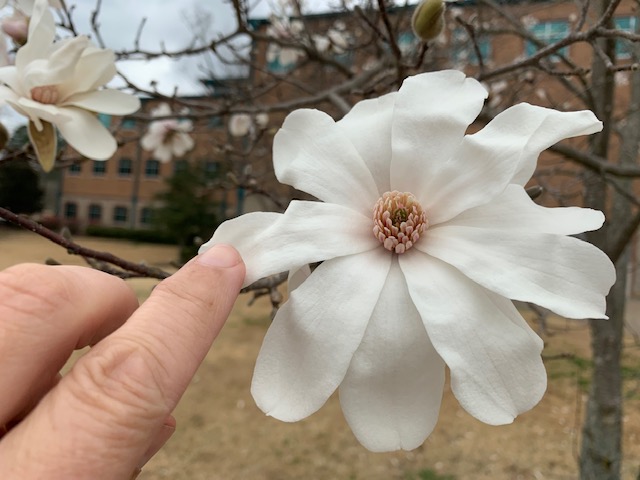
One of the earliest small flowering trees in our landscape are the deciduous Magnolias. Here we have Star Magnolia, Magnolia stellata. This small multi-trunked tree, at maturity can reach up to 20 feet tall. It will grow in full sun to partial-shade. It is a show stopper when in bloom and will fit in a small spot in the yard. This one is almost in full bloom outside my office in Little Rock.

Sedums have become popular in recent years. I really like the creeping type, sometimes referred to as stonecrop sedums. Some of them, like this golden sedum, take on a vibrant winter color. This one can brighten up an otherwise drab perennial border while all the other perennials are still dormant. I found this one growing in the display beds at Good Earth Garden Center in Little Rock.

Flowerbeds and containers which have winter bedding plants could use a shot of fertilizer. These panolas and peacock kale have bounced back from the recent cold weather we had in central Arkansas. The kale will soon start to bloom with yellow flowers. Many gardeners cut them back once they start to bloom, but I encourage gardeners to leave them. These flowers are rich in nectar and pollen which bees are in great need of at this time.

Tete-a-tete daffodils, Narcissus ‘Tete-a-Tete’., grow only 6 – 8 inches tall. In most years, it is the first daffodil to bloom in my Fayetteville garden.This daffodil looks great along landscape borders, rock garden or in perennial beds like the one seen here. It multiplies freely so should be divided every 5 to 10 years to prevent overcrowding of the bulbs. Like all bulbous plants, the bulbs should be planted in well drained soil. Allow the foliage to remain at least eight weeks after flowers fade to provide nourishment for next year’s blooms. Just to the left of this clump of daffodils, is Ginger, Asarum arifolium. Plants of the genus asarum have a scent somewhat like that of the culinary ginger but they are not used as seasoning. This low creeping plant, makes a very attractive woodland ground cover. Most asarum species are evergreen and deer resistant. They do bloom, but the small dark flowers are low to the ground and most often not seen. There are a few asarum species that do produce large flowers, yet they are most often found under the foliage hugging the soil.
Arkansas Flower & Garden Show
The Arkansas State Fairgrounds is the place for novice and experienced gardeners to be this weekend, February 28 through March 1, 2020. The Arkansas Flower & Garden Show brings to one place, experts in the fields of plant cultivation, propagation, and plant disease prevention and treatment. This year’s show includes leading nurserymen, designers, naturalists and artisans. There are over 140 vendor booths at the show selling everything from plants, tools, furniture, and bird houses to organic cosmetics, housewares, and jewelry. For details, visit the shows website at https://argardenshow.org/
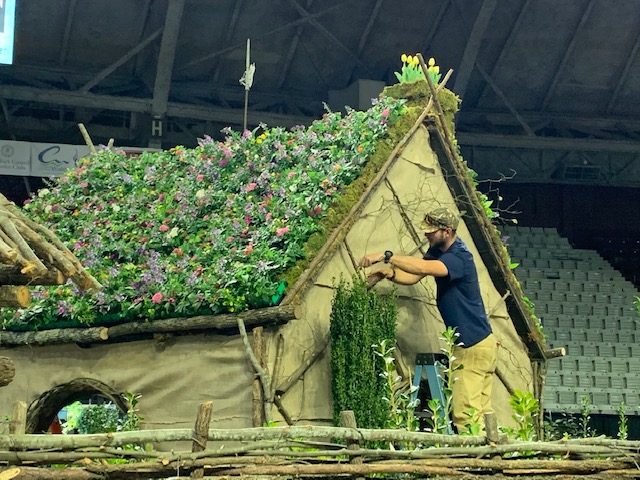
Barton Coliseum has been going through a garden transformation the last three days and will be ready for public viewing Friday February 28. Show hours are 9:00 am – 5:00 pm Friday and Saturday and on Sunday 10:00 am – 3:00 pm.
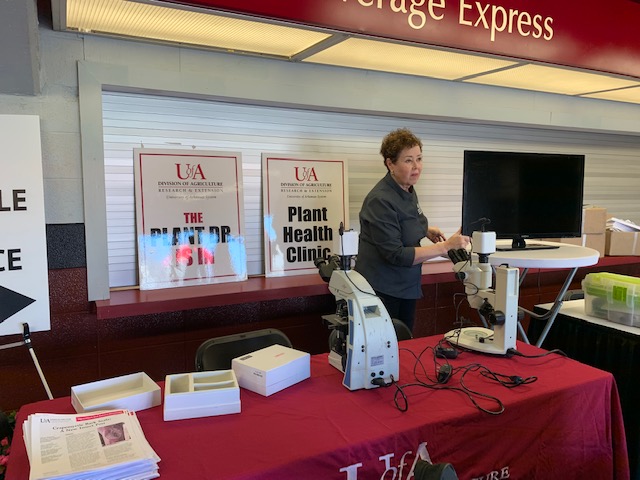
Sherrie Smith, plant diagnostician for the University of Arkansas Division of Agriculture Cooperative Extension Service, will be on hand to discuss plant issues. Bring plant samples to her at her booth. She will provide recommendations to you before you leave.

Master Gardeners with the Statewide Advisory group, County 76, have garden tools and gadgets for sale at this years show.

Julie and I setup the “Join Master Gardeners” booth today and ready to promote others to join this great volunteer organization. Come by our booth and say hello.

If you are coming to the show to volunteer, you will need to check in at this booth which located at the East entrance.

This show is an excellent place to buy the unusual garden plants. This is one of the newer Hellebores (Lenten Rose) which you will find on display in my booth. Come to my booth and you will learn where you can go to purchase this particular variety. Hope to see you at this year’s show!
Winter Blues/Where is Spring?
This past week was tough. For the most part it was overcast, cold and damp which is not untypical for February in our region. But the weather added to the fact that I had the dreaded “Flu”, made it a very “Blue” week for me. What made it even worse is that my wife came down with the Flu as well. I had to cancel 3 speaking engagements which I’m now trying to re-schedule into an already busy spring. Although I had the Flu shot, I feel very fortunate to have bounced right back to good health. My Doctor cleared me and said that I’m good to go.

These are houseplants in my South facing bay window. The key to houseplant winter health is, good light and keeping water at minimum. A cool damp soil is not good for any tropical plant. I will resume fertilizing in about 6 weeks. This collection of houseplants was good “Plant Therapy” for me this past week.

I ventured outside once I started feeling better on Saturday and found Snowdrops (Galanthus nivalis) in bloom. Snowdrops are a welcome site in February. These are planted at the base of a Japanese maple.

Blooming in my back yard I found a native shrub the Ozark Witch Hazel, Hamamelis vernalis, blooming its heart out. This multi-trunked winter-blooming deciduous shrub grows 10-12 feet tall. Clustered flower buds, growing from previous year’s stems, are rounded and stalked with several flowers per stalk. Flowering begins in early winter and continues into early spring. Fragrant flowers, ½ inch wide and long, have four ribbon-like reddish to yellowish petals and four short stamens. Petals roll up on very cold days to avoid freeze damage. Ozark witch hazel has good specimen value in a garden setting or in a naturalized area. It grows well in moist well-drained soil in full sun to part shade, with best flowering in full sun. Established plants are drought tolerant. I find this to be very true because you will find this Witch Hazel in my backyard in full sun on a severe slope.
Winters Grip
Cold temperatures have returned, reminding our gardens that it’s not time yet. Although most of us are ready for spring’s arrival, the last 2 weeks of January and the first 2 weeks of February are on the average our coldest part of winter. So, hunker down. The next couple of days has some winter mix predictions for some parts of the State which has many kids excited.

I was in Jonesboro on Friday where I captured these daffodils already in bud. In central Arkansas and to our Southern border, some daffodils are in bloom. Daffodils can tolerate freezing temperatures without much concern. However, I would consider covering blooming daffodils only if temperatures are predicted to fall into the low teens.
This japanese maple is showing signs of winter/cold damage. The sudden drop in temperature last fall (November 11), caught many of our landscape plants not acclimated to winters cold. It is way to early to determine the severity and extent of damage to our landscape plants. Right now, take note of what you are seeing in your landscape, knowing that you may have to address some of this later this spring to summer. Yes, some winter damage is not expressed in some plants until early summer, when plants can suddenly collapse. Do not prune any plants at this point. I will provide pointers as the season progresses.

This living wall at the new Embassy Suites in Jonesboro is providing the fix we all need during these cold winter days. I spent last Thursday and Friday here, working on details of this years Master Gardener Conference, May 14-16.
Pansies are Looking Good!
Pansies and other cool season annuals have been performing very nicely for us this winter. Other than the winter blast we had in November, our winter has been mild for these annuals to really shine. Plant winter annual transplants by end of October and they typically will withstand our coldest winters. If you didn’t get around planting some this past fall, you can still enjoy cool season annual color by planting them from mid-February into March. Winter annuals are heavy feeders so they do benefit from applying additional nutrients. Initial fertilization is made at planting and then hold off until mid-February to give them a boost to make them pop. Make a second spring application mid to late March to carry the color into May. Expand your winter annual palette by planting Dianthus, Swiss Chard, Flowering Kale, Dusty Miller, Snap Dragons, or Ornamental Cabbage. In protected areas you can plant Sweet Alyssum and Calendulas as well.

This is one of two planters which the Pulaski County Master Gardeners plant and maintain which are located at the public entrance to my office at the University of Arkansas Cooperative Extension Service headquarters in Little Rock. This mix (pansies, kale, cabbage, swiss chard and rosemary) was planted before our cold blast in November. Everything survived except the Rosemary on the backside. The second Rosemary was planted by early December. Rosemary is marginally hardy and does fine for us most winters. Here in Little Rock, we are expected to get to the low 20’s by late weekend. If this Rosemary was at my house, I would cover it to soften the blow of this encroaching winter blast.

